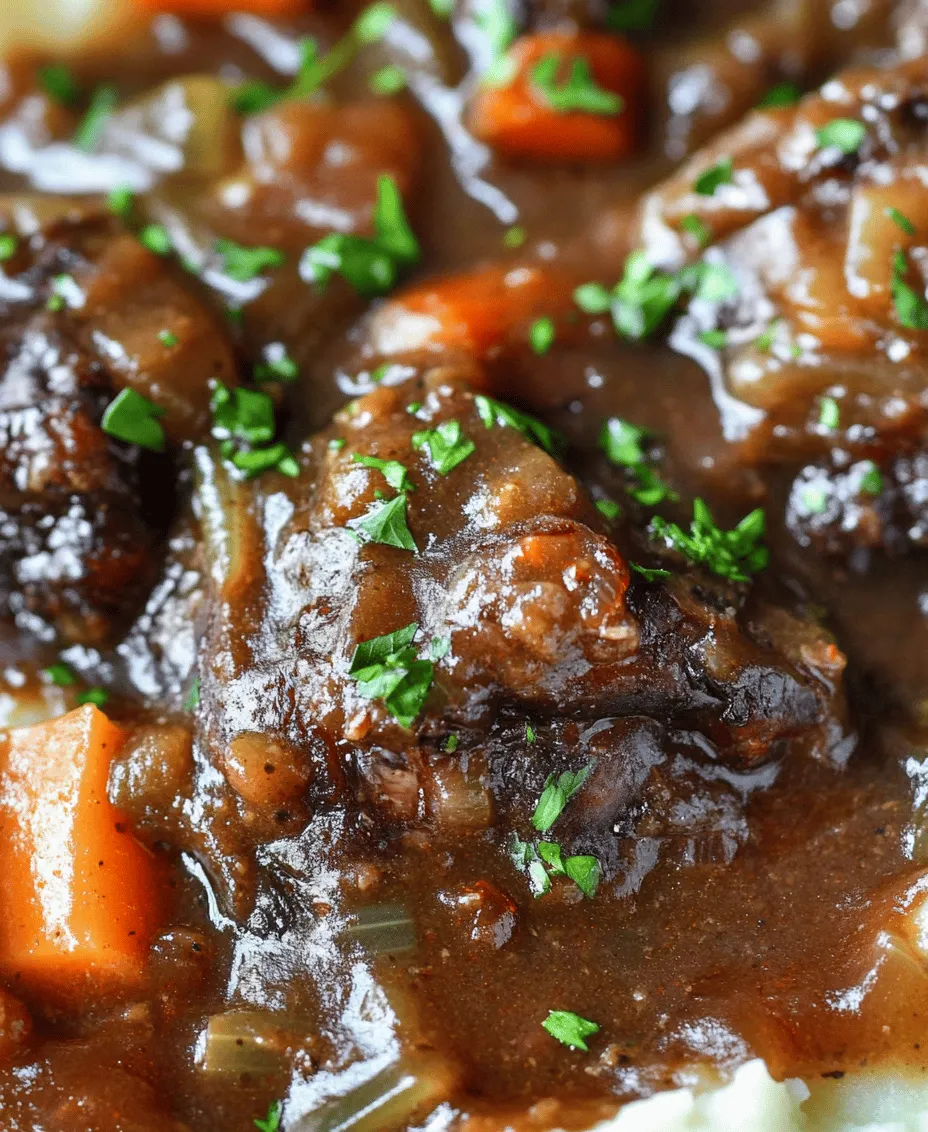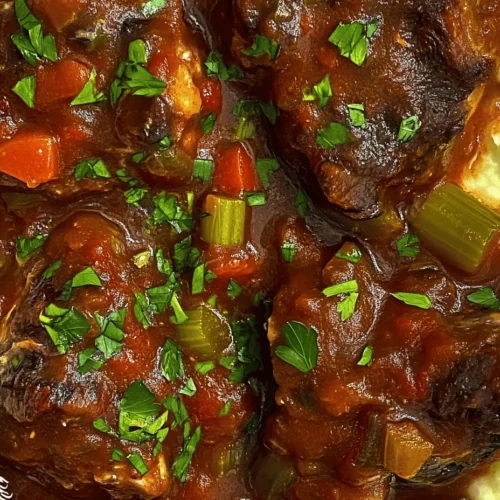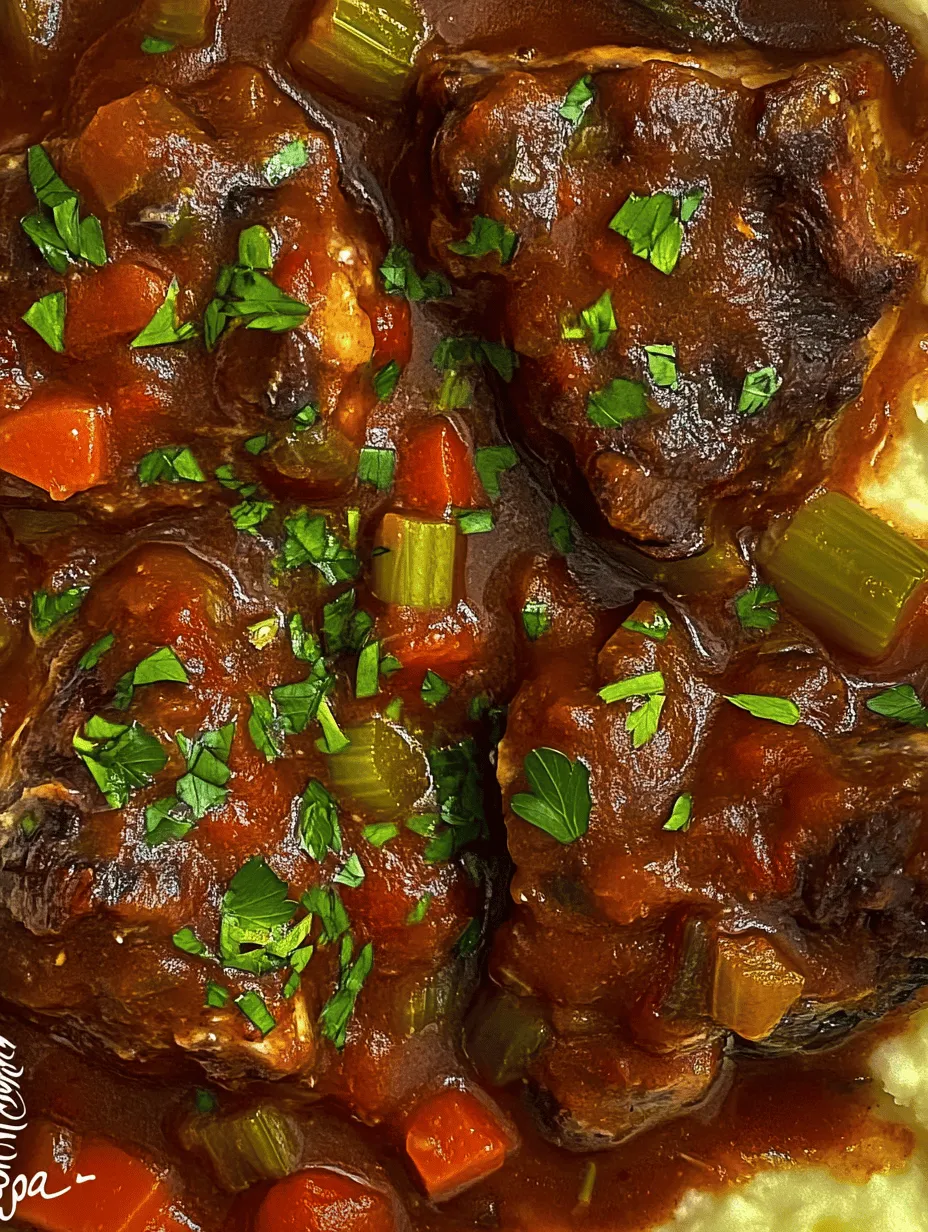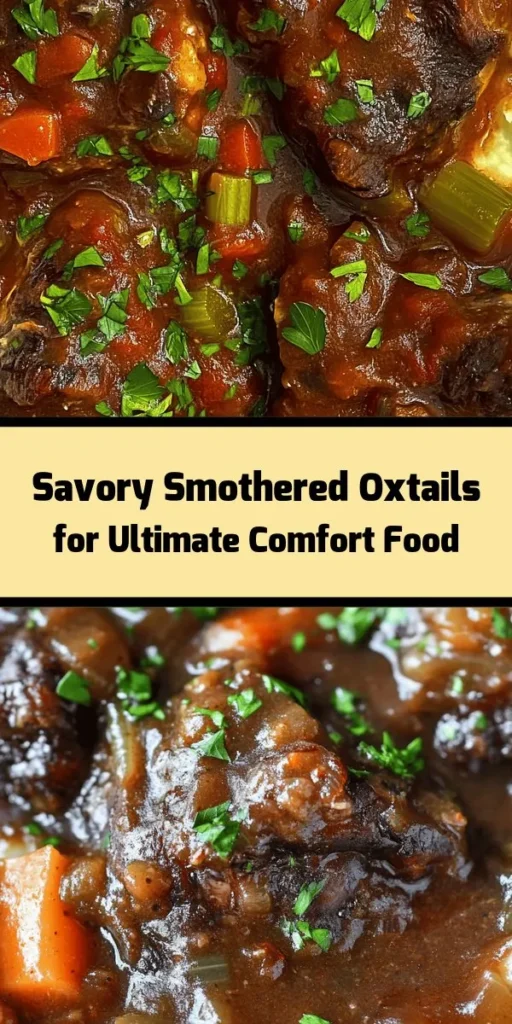Introduction
Oxtails, often regarded as a hidden gem in the world of culinary delights, have surged in popularity in recent years. These meaty tails, which come from the hindquarters of cattle, are a rich source of flavor and texture that, when cooked properly, can elevate any meal to something truly memorable. The key to preparing oxtails lies in the art of slow cooking. This process not only tenderizes the meat but also infuses it with a medley of flavors, creating a dish that is both hearty and satisfying.
In this recipe, we will explore the process of crafting decadent smothered oxtails, a dish that brings together a symphony of flavors and aromas. Expect tender meat enveloped in a luscious sauce, perfect for serving over rice or mashed potatoes. If you’re ready to impress your family and friends with an unforgettable meal, read on to discover the secrets behind this sumptuous dish.
Understanding Oxtails
Oxtails are exactly what their name suggests—the tails of cattle. Traditionally, they were considered a byproduct of butchering, often overlooked in favor of more popular cuts of meat. However, their unique flavor and texture have earned them a special place in many kitchens around the world.
Historically, oxtails have been used in various cuisines, from hearty stews in Caribbean cooking to the rich and flavorful Italian “coda alla vaccinara.” Each culture has its own way of preparing and enjoying oxtails, often incorporating regional spices and cooking techniques that highlight their versatility. In addition to being delicious, oxtails boast several nutritional benefits. They are high in collagen, which promotes healthy skin and joints, and they also provide a good source of protein. Incorporating oxtails into your meals can be a delightful way to enjoy a nutritious dish while exploring global culinary traditions.
Ingredients Breakdown
To create the perfect decadent smothered oxtails, you will need a selection of key ingredients. Each component plays a crucial role in building layers of flavor that will make this dish unforgettable.
Main Ingredients
1. Oxtails: The star of the show, oxtails are rich in flavor and become incredibly tender when slow-cooked. Aim for well-marbled pieces for the best texture.
2. Vegetables: Common choices include onions, carrots, and celery. These aromatic vegetables form the flavor base for the sauce and add sweetness.
3. Garlic: Fresh garlic provides a robust aroma and depth of flavor.
4. Tomato Paste: This ingredient adds richness and a hint of acidity, balancing the dish’s overall flavor profile.
5. Broth: Beef broth enhances the meaty flavor of the oxtails and contributes to the sauce’s consistency.
6. Red Wine: Used for deglazing the pot, red wine adds depth and complexity. It is essential for extracting the flavorful bits left in the pan from searing the oxtails.
7. Herbs and spices: Fresh thyme, bay leaves, salt, and pepper are typically used to season the dish. Feel free to experiment with your favorite herbs.
Importance of Each Ingredient
The combination of these ingredients is what transforms simple oxtails into a decadent dish. The oxtails provide the primary flavor, while the vegetables contribute sweetness and aromatic qualities. Tomato paste and broth create a rich and hearty sauce that clings to the meat, while red wine deglazes the pan, enriching the overall flavor. Herbs and spices enhance the complexity of the dish, making each bite a delightful experience.
Suggestions for Ingredient Substitutions
If you’re unable to find certain ingredients or prefer alternatives, here are some helpful substitutions:
– Oxtails: If oxtails are unavailable, consider using beef shanks or short ribs, though the flavor will differ slightly.
– Red Wine: If you prefer not to use wine, you can deglaze with additional beef broth or a splash of balsamic vinegar for acidity.
– Vegetables: Feel free to mix in other vegetables like bell peppers or mushrooms for added flavor and texture.
Preparation Steps for Decadent Smothered Oxtails
Creating decadent smothered oxtails involves several key steps that enhance the dish’s flavor and texture. Below, we provide detailed instructions to guide you through the preparation process.
Searing the Oxtails
The first step in preparing your smothered oxtails is to sear them properly. Start by seasoning the oxtails generously with salt and pepper. Heat a large, heavy-bottomed pot or Dutch oven over medium-high heat and add a drizzle of oil. Once the oil is hot, carefully add the oxtails in batches, ensuring not to overcrowd the pan.
Importance of Browning for Flavor
Browning the oxtails creates a flavorful crust that enhances the overall taste of the dish. This process, known as the Maillard reaction, develops rich, complex flavors that will be the foundation of your sauce.
Tips for Achieving the Perfect Sear
– Don’t rush: Allow the oxtails to sear undisturbed until a deep brown crust forms. This may take 5-7 minutes per side.
– Work in batches: If you’re cooking a large quantity, searing in batches prevents steaming and ensures an even browning.
– Use the right oil: Opt for oils with a high smoke point, such as canola or grapeseed oil, to withstand the high heat without burning.
Once the oxtails are beautifully browned, remove them from the pot and set them aside on a plate.
Sautéing the Vegetables
In the same pot, add the chopped onions, carrots, and celery. Sauté for about 5 minutes or until the vegetables are softened and fragrant.
Explanation of How Sautéing Enhances the Dish
Sautéing the vegetables not only develops their natural sweetness but also captures the flavorful bits stuck to the bottom of the pot from searing the oxtails. These bits, known as fond, are essential for creating a rich sauce.
Recommended Vegetable Combinations and Variations
While the classic mirepoix of onions, carrots, and celery works beautifully, feel free to experiment with other vegetables to suit your taste. Consider adding:
– Bell peppers: For a hint of sweetness and color.
– Garlic: Sautéing minced garlic alongside the vegetables adds a fragrant and robust flavor.
– Mushrooms: Earthy mushrooms complement the richness of the oxtails and add depth to the dish.
Deglazing the Pot
Once the vegetables are sautéed, it’s time to deglaze the pot. Pour in the red wine, scraping the bottom of the pot with a wooden spoon to release the flavorful bits. This step is crucial for building depth in your sauce.
Importance of Deglazing for Depth of Flavor
Deglazing not only helps to incorporate those crispy bits into the dish but also adds acidity and complexity from the wine. As the wine reduces, it concentrates the flavors, creating a robust base for your sauce.
Discussing the Role of Red Wine and Alternatives
Red wine brings a unique depth to the dish, but if you prefer to skip it, consider using additional beef broth or a splash of balsamic vinegar for acidity. The goal is to add a dimension of flavor that balances the richness of the oxtails.
Adding Remaining Ingredients
After deglazing, return the oxtails to the pot, along with the tomato paste, broth, herbs, and spices. Stir to combine all the ingredients, ensuring that the oxtails are well-coated in the sauce.
Now that you have completed the initial preparation steps, the smothered oxtails are ready to be cooked low and slow. The next phase will involve letting these flavors meld together in the pot, resulting in an incredibly tender and flavorful dish that is sure to impress.
Stay tuned for the continuation of this recipe, where we will explore the cooking process and additional tips for achieving the perfect decadent smothered oxtails.

Flavor Profiles of Smothered Oxtails
When it comes to creating a dish as rich and satisfying as smothered oxtails, understanding the flavor profile is essential. Each ingredient contributes uniquely to the overall taste experience. Oxtails, with their rich, meaty flavor and succulent texture, serve as the star of the show. The long, slow cooking process enhances their natural depth, allowing for a melt-in-your-mouth experience. The braising liquid, typically a blend of broth, wine, and aromatics, introduces layers of flavor through both acidity and sweetness, balancing the richness of the meat.
The Role of Spices and Seasonings in Enhancing Taste
In smothered oxtails, the spices and seasonings play a crucial role in building complexity. Common ingredients such as garlic, onion, bay leaves, thyme, and peppercorns add aromatic depth. The inclusion of spices like paprika or cayenne can introduce subtle heat, which complements the dish without overwhelming it. The careful selection and balance of these flavors ensure that the oxtails are not just tender but also bursting with personality.
Returning the Oxtails and Braising
Once your oxtails have been seared to perfection, it’s time to incorporate them back into the pot with the braising liquid. This step is pivotal for infusing the meat with flavor. Here’s how to proceed:
1. Add the Oxtails: Place the seared oxtails back into the pot, nestling them into the aromatic mixture of vegetables and spices.
2. Pour in the Braising Liquid: Carefully add your broth or wine mixture, ensuring that the oxtails are mostly submerged. This liquid will help transform the oxtails into a tender, flavorful dish.
3. Cover and Cook: Bring the mixture to a gentle simmer, then cover the pot with a tight-fitting lid. This helps trap moisture and allows the flavors to meld beautifully during cooking.
Description of the Braising Process
Braising is a two-step cooking method that begins with browning the meat and ends with slow cooking in a liquid. In the case of smothered oxtails, the initial searing caramelizes the surface, developing rich, complex flavors. After returning the oxtails to the pot, the braising process continues by cooking them in a low-temperature oven or on the stovetop for several hours. The gentle heat allows the collagen in the oxtails to break down, resulting in tender meat that falls off the bone.
Importance of Low and Slow Cooking for Tenderness
The key to achieving perfectly tender oxtails lies in the low and slow cooking method. Cooking at a low temperature for an extended period allows the connective tissues to soften and break down. This is where the magic happens; the longer you cook the oxtails, the more tender and flavorful they become. Aim for a cooking time of about 2.5 to 3 hours, checking periodically for tenderness. The meat should be easy to pull away from the bone when it’s ready.
Tips for Monitoring the Cooking Process
While the oxtails braise, it’s important to keep an eye on the cooking process to prevent drying out or overcooking. Here are some helpful tips:
– Check Liquid Levels: Ensure there’s enough braising liquid throughout the cooking process. If it looks too low, add a bit more broth or water to keep the oxtails submerged.
– Adjust Temperature: If the braising liquid starts bubbling too vigorously, reduce the heat. A gentle simmer is ideal for tenderizing the meat.
– Taste and Adjust: About halfway through the cooking time, taste the braising liquid and adjust the seasoning if necessary. This is also a great time to add any additional spices or herbs to enhance the flavor.
Thicken the Sauce (Optional)
Once your oxtails are tender and you’re ready to finish the dish, you may want to thicken the sauce for a more luxurious consistency. Here are some effective techniques for thickening:
1. Reduce the Sauce: After removing the oxtails, increase the heat to bring the braising liquid to a vigorous boil. Allow it to reduce for 10-15 minutes until it thickens to your desired consistency.
2. Cornstarch Slurry: Mix equal parts cornstarch and cold water to create a slurry. Gradually stir this into the simmering braising liquid and cook for a few more minutes until thickened.
3. Puree Vegetables: If you prefer a more natural thickener, remove some of the cooked vegetables from the pot, puree them in a blender, and stir them back into the sauce.
How to Ensure the Sauce Complements the Oxtails Without Overpowering Them
When thickening the sauce, it’s crucial to strike a balance so that the flavors remain harmonious. Here’s how to ensure the sauce complements the oxtails:
– Taste Test: Always taste the sauce after thickening. Adjust with salt, pepper, or a splash of vinegar to brighten the flavors without overpowering the oxtails.
– Consistency Check: The sauce should be thick enough to coat the back of a spoon but not so thick that it overshadows the rich flavor of the oxtails.
Serving Suggestions
Smothered oxtails are not only delicious but also versatile in terms of pairing with side dishes. Here are some ideas to elevate your meal:
– Comforting Carbs: Serve your oxtails over a bed of creamy mashed potatoes, fluffy rice, or buttery polenta. These options soak up the flavorful sauce and provide a satisfying base.
– Vegetable Sides: Roasted or sautéed greens, such as collard greens, green beans, or roasted carrots, add a pop of color and nutrition to the plate.
– Breads: A crusty loaf of bread or cornbread is perfect for mopping up the delightful sauce.
Creative Plating Ideas to Elevate Presentation
Presentation is key in making your dish visually appealing. Here are some creative plating ideas for your smothered oxtails:
– Layering: Start with a generous portion of your starch, then top with oxtails and a drizzle of sauce. Garnish with fresh herbs like parsley or thyme for a burst of color.
– Use of Bowls: Consider serving the oxtails in deep bowls instead of plates, allowing the sauce to pool beautifully around the meat.
– Garnishes: A sprinkle of finely chopped scallions or a dollop of sour cream can add freshness and contrast against the rich flavors of the dish.
Cultural Variations of Oxtail Dishes
Oxtails have found their way into many culinary traditions around the world, each bringing its unique twist to this flavorful ingredient.
Overview of Different Culinary Traditions Featuring Oxtails
– Caribbean: In Caribbean cuisine, oxtails are often slow-cooked with spices like allspice, ginger, and Scotch bonnet peppers, creating a dish that’s both spicy and savory.
– Southern: Southern smothered oxtails typically feature a rich gravy made with onions and flour, served over rice or with cornbread.
– Asian: In Asian cultures, oxtails are often braised in soy sauce, star anise, and ginger, resulting in a sweet and savory flavor profile.
Comparison of Preparation Styles
While the basic principles of braising remain constant, the spices and methods vary widely:
– Caribbean oxtails are known for their bold flavors and heat, achieved through the use of Scotch bonnet peppers and Caribbean spices.
– Southern-style oxtails lean towards a creamy, rich gravy, often incorporating elements like Worcestershire sauce and hot sauce for depth.
– Asian-inspired recipes tend to emphasize soy sauce and sesame oil, with accompanying vegetables such as bok choy and mushrooms for added texture and flavor.
Unique Flavors and Techniques from Around the World
The beauty of oxtails is their adaptability to various flavor profiles. Experimenting with different spices and cooking techniques from various cultures can yield delightful results. For instance, using a Caribbean spice blend can completely transform the flavor, while an Asian approach might incorporate rice wine and five-spice powder, creating a dish that feels entirely new.
Conclusion
Cooking oxtails is not just about the recipe; it’s about the experience—creating a dish that comforts and satisfies. With their rich flavor and tender texture, smothered oxtails become a centerpiece for gatherings and family meals. They invite you to explore the depths of flavor through the careful selection of ingredients and the art of braising.
As you embark on your journey to create decadent smothered oxtails, remember to embrace the process. Cooking is an opportunity for creativity and experimentation. Whether you stick to traditional pairings or branch out into new culinary territories, the joy of preparing a homemade meal featuring this delightful dish is unparalleled. So gather your ingredients, invite friends or family to join, and enjoy the comfort and satisfaction that comes from a lovingly prepared meal.



